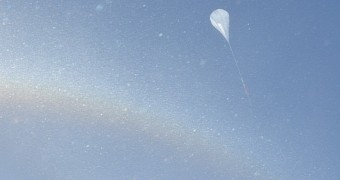A couple of days ago, on December 28, scientists with NASA launched a mammoth 532,000-cubic-meter (that's a jaw-dropping 18,787,402 cubic feet, in case anyone was wondering) balloon. No, they did not do it for fun, but for research purposes.
Thus, the balloon is expected to explore the skies in search of high-energy particles originating from space and report its findings to researchers on the ground. The end goal is to learn more about the universe we live in, NASA explains.
Possibly the coolest balloon ever to take to the skies
Information shared with the public says that the balloon, featured in the photo accompanying this article, was launched from a site not far from the McMurdo Station, a research center located on the southern tip of Ross Island in the Antarctica.
Positively mind-boggling size aside, word has it that the balloon is carrying an impressive 2,300 kilograms (roughly 5,070 pounds) worth of equipment. Having reached an altitude of about 33.5 kilometers (nearly 21 miles), the balloon should remain airborne for at least 100 days.
Mind you, this isn't the first scientific balloon NASA has until now launched. Still, it's important to note that all the other ones that have so far taken to the skies only remained up in the air for about 50 days, during which time they circled Antarctica once or twice.
The scientists behind this ambitious project fear that, seeing how this scientific balloon that was launched last Sunday is bound to remain airborne for at least 100 days, it could be carried by winds out of Antarctica and over other patches of land.
To avoid conflicts, NASA had to get permission from countries whose aerospace might be visited by its installation before actually moving on with plans to launch the balloon. Luckily, nobody tried to sabotage the agency's endeavor.
The scientific balloon's working agenda
Researchers explain that this latest NASA scientific balloon is fitted with a γ-ray telescope, i.e. the Compton Spectrometer and Imager, that will serve to detect high-energy photons originating from space. This telescope is positioned is such a way that it can scan 50% of the skyline above it in one day.
NASA assumes that, with the help of this telescope and the scientific balloon carrying it, it will manage to gain a better understanding of black holes, stars that emit rapid and periodic pulses of radiation and that are consequently known as pulsars, and other phenomena now going on in space.
It is expected that, the more time the scientific balloon spends up in the sky and the more information concerning high-energy photons the Compton Spectrometer and Imager attached to it manages to obtain, the easier it will be for researchers to make observations about the anatomy of the cosmos.
“The long flight time is key for this study,” team leader Steven Boggs, an astrophysicist currently working with the University of California, Berkeley, commented on this research project in a recent interview, as cited by Nature.

 14 DAY TRIAL //
14 DAY TRIAL //